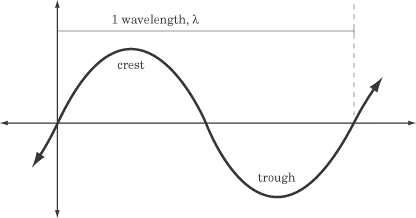Lesson: Chapter - 17
Wave Motion
Because both masses suspended on a spring and waves at the beach exhibit
periodic motion, we can use much of the same vocabulary and mathematical tools
to describe both. However, there is a significant difference: waves are extended
in space, while a mass on a spring just oscillates back and forth in one place.
The Basics
A familiar and concrete example of wave motion is the “wave” spectators create
at sporting events by standing up and sitting down at appropriate intervals.
Each person stands up just as that person’s neighbor stands up, transmitting a
form of energy all the way around the stadium. There are two things worth noting
about how this works:
- Waves are transmitted through a medium: The energy and the “wave” are
both created by the successive action of people standing up and down. If there
were no people in the stadium, no wave could exist and no energy could be
transmitted. We call the people at the stadium, the water at the beach, the air
molecules transmitting sound, etc., the medium through which these waves are
transmitted.
- The medium itself is not propagated: For the “wave” to work, each person
in the stadium only needs to stand up and sit back down. The “wave” travels
around the stadium, but the people do not.
Think of waves as a means of transmitting energy over a distance. One object can
transmit energy to another object without either object, or anything in between
them, being permanently displaced. For instance, if a friend shouts to you
across a room, the sound of your friend’s voice is carried as a wave of agitated
air particles. However, no air particle has to travel the distance between your
friend and your ear for you to hear the shout. The air is a medium, and it
serves to propagate sound energy without itself having to move. Waves are so
widespread and important because they transmit energy through matter without
permanently displacing the matter through which they move.
Crests, Troughs, and Wavelength
Waves travel in crests and troughs, although, for reasons we will
discuss shortly, we call them compressions and rarefactions when
dealing with longitudinal waves. The terms crest and trough
are used in physics just as you would use them to refer to waves on the sea: the
crest of a wave is where the wave is at its maximum positive displacement from
the equilibrium position, and the trough is where it is at its maximum negative
displacement. Therefore, the displacement at the crest is the wave’s amplitude,
while the displacement at the trough is the negative amplitude. There is one
crest and one trough in every cycle of a wave. The wavelength,
?,
of a traveling wave is the distance between two successive crests or two
successive troughs.

Wave Speed
The period of oscillation, T, is
simply the time between the arrival of successive wave crests or wave troughs at
a given point. In one period, then, the crests or troughs travel exactly one
wavelength. Therefore, if we are given the period and wavelength, or the
frequency and wavelength, of a particular wave, we can calculate the wave
speed, v:
v = ? / T = ? ƒ
Example
Ernst attaches a stretched string to a mass that oscillates up and down once
every half second, sending waves out across the string. He notices that each
time the mass reaches the maximum positive displacement of its oscillation, the
last wave crest has just reached a bead attached to the string 1.25 m away. What
are the frequency, wavelength, and speed of the waves?
Determining frequency:
The oscillation of the mass on the spring determines the oscillation of the
string, so the period and frequency of the mass’s oscillation are the same as
those of the string. The period of oscillation of the string is
T =
0.5 s, since the string oscillates up and down once every half second.
The frequency is just the reciprocal of the period:
f = 1/T = 2
Hz.
Determining wavelength:
The maximum positive displacement of the mass’s oscillation signifies a wave
crest. Since each crest is 1.25 m apart,
the wavelength,
?,
is 1.25 m.
Determining wave speed:
Given the frequency and the wavelength, we can also calculate the wave speed:
v = ƒ? = (2Hz)(1.25m) = 2.5 m/s.
Phase
Imagine placing a floating cork in the sea so that it bobs up and down in the
waves. The up-and-down oscillation of the cork is just like that of a mass
suspended from a spring: it oscillates with a particular frequency and
amplitude.

Now imagine extending this experiment by placing a second cork in the water a
small distance away from the first cork. The corks would both oscillate with the
same frequency and amplitude, but they would have different phases: that
is, they would each reach the highest points of their respective motions at
different times. If, however, you separated the two corks by an integer multiple
of the wavelength—that is, if the two corks arrived at their maximum and minimum
displacements at the same time—they would oscillate up and down in perfect
synchrony. They would both have the same frequency and the same phase.
Back
Next
Next to display next topic in the chapter.
Practice Questions
Video Lessons and 10 Fully Explained Grand Tests
Large number of solved practice MCQ with explanations. Video Lessons and 10 Fully explained Grand/Full Tests.